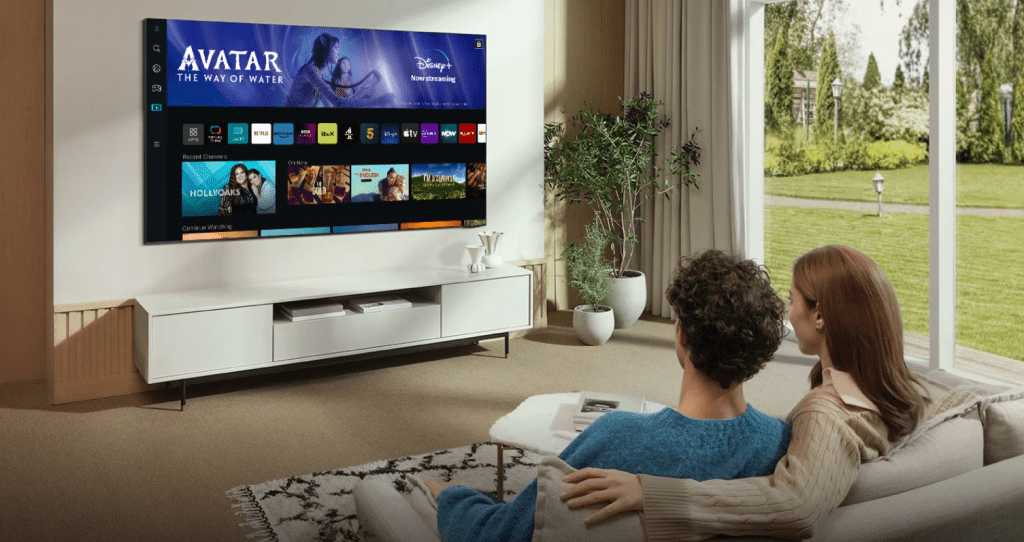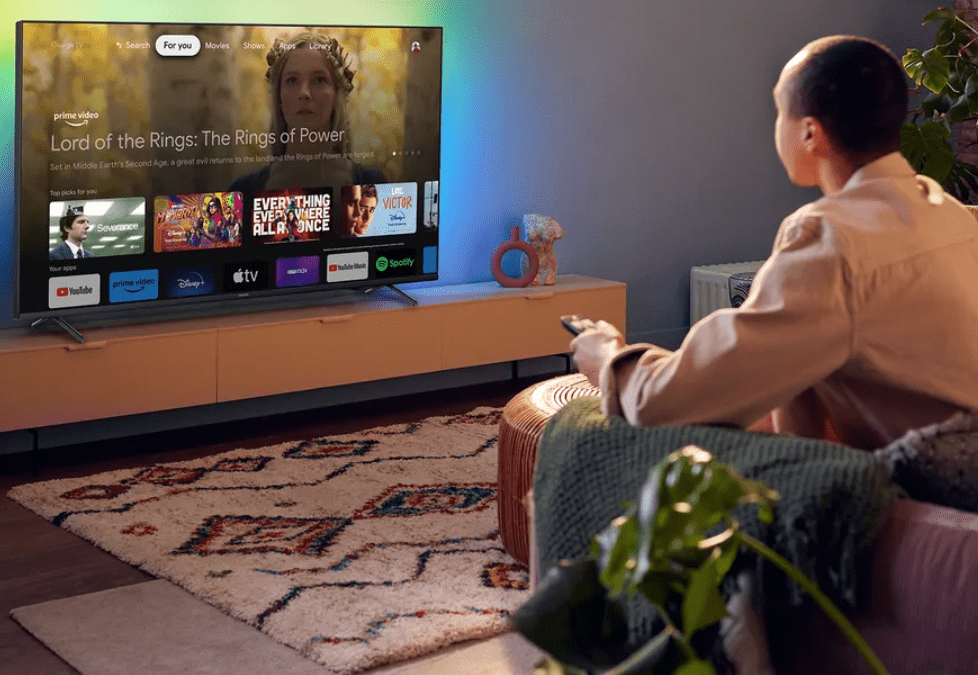In an era where an increasing number of viewers are turning to Smart TVs for content consumption, Multi-DRM emerges as the essential solution to address the growing fragmentation within the broadcast ecosystem.
These Smart TVs are now the primary gateway for viewers to access both linear television and streaming services. In the UK, Smart TVs have become the predominant choice for TV viewing, while in the US, 50% of broadband households own one, with a remarkable 77% of these sets connected to the internet, totaling over 80 million devices.
Furthermore, Smart TV sales continue to surge, with 198 million units shipped in 2018. Projections indicate that this number will climb to 266 million by 2025, constituting a significant portion of global TV set shipments. These Smart TVs, equipped with user-friendly app ecosystems, have enabled widespread cord-cutting and cord-shaving practices. Leading manufacturers include pre-installed apps for major OTT (Over-The-Top) streaming platforms on both an international and national scale. Expanding content options has become as simple as visiting the TV’s built-in app store within its user interface.
However, the success story of Smart TVs is not without its challenges, particularly when it comes to safeguarding video content through Digital Rights Management (DRM). This issue is of paramount importance in the ever-evolving broadcast ecosystem that is taking shape as a result of these technological advancements.
The problem of DRM on Smart TVs

The challenge arises from the fundamental shift in the broadcast ecosystem. Unlike the Set-Top Box (STB)-driven broadcast environment, which was largely controlled by broadcasters and operators as the equipment suppliers, the Smart TV market has been driven by consumer preferences. With the transition of the video service delivery point from STBs to Smart TVs, certain aspects of the service, including content protection, have moved beyond the influence of operators.
Content protection mechanisms now depend on the Smart TV manufacturers and are often implemented in a somewhat arbitrary manner. As we will explore in the next section, what functions smoothly on one Smart TV may not necessarily work on another.
There are additional complexities in this landscape. For example, Hollywood Studios demand some form of hardware security to safeguard high-quality 4K content, a requirement that often involves HDCP 2.x ‘handshakes’ before signals can be transmitted to other devices, such as soundbars. On the other hand, many OTT operators aim to ensure that their content can directly reach viewers’ screens without any third-party intervention.
The outcome of these diverse demands is that DRM, which originally stands for Digital Rights Management, might as well be interpreted as Digital Rights Mess. This situation was starkly exemplified in November 2019 when a significant number of Smart TV owners encountered an error message stating that ‘Netflix will no longer be available on this device after December 1st, 2019’.
This message impacted viewers using older Samsung and Vizio Smart TV sets, as well as some Roku devices in the US and Canada. The issue revolved around Netflix discontinuing support for an older DRM standard, Windows Media DRM, which was present on devices sold between roughly 2010 and 2014, even though Netflix had adopted Microsoft PlayReady in 2010.
A Roku spokesperson conveyed that many affected devices were eight to ten years old and highlighted that older hardware eventually becomes incompatible with new software. Nevertheless, this incident underscored the potential issues within DRM and reaffirmed the industry’s understanding of the value of Multi-DRM solutions—content protection solutions capable of accommodating multiple forms of DRM in a device-agnostic manner.
The fragmented picture of current DRM
Multi-DRM is an area in which we possess extensive expertise. Multi-DRM is fundamentally the solution to the challenges posed by a fragmented marketplace. It is a technology that enables us to address the complexities of multiple DRM systems and support various delivery systems within a single product.
This comprehensive approach is indispensable because, while the market may seem supportive of standards on the surface, a closer look reveals a different reality. Behind the scenes, a considerable amount of sophisticated technology is required to ensure a seamless video delivery experience for consumers.
To start, there are numerous streaming protocols in play. As digital video delivery has gained momentum, tech giants have developed their own systems for adaptive bitrate streaming over the years. Microsoft Smooth Streaming (MSS) initially led the market, but with the launch of the iPhone, Apple introduced HLS (HTTP Live Streaming), and subsequently, MPEG-DASH—an HTTP-based solution that has become an international standard with support from Google.
HLS and DASH have become dominant in the market, which seems straightforward. However, the complexity arises when DRM is introduced.
In the realm of video delivery to consumer devices, three primary DRM systems are in use. While they exhibit nuances in their operations, broadly speaking, they all revolve around verifying the identity of a playback device and providing a license for content playback. These systems are Google’s Widevine (utilized by Amazon Prime Video), Microsoft’s PlayReady (employed by Netflix), and Apple’s FairPlay (found in iTunes and Apple TV+).
In the context of Smart TVs, FairPlay can be excluded from the discussion for the time being, although it’s not entirely inconceivable that Apple may introduce its own TV set in the future. Nevertheless, this still leaves us with a rapidly evolving landscape of protocols that not every Smart TV supports.
For instance, older Samsung sets lack support for Widevine, Panasonic sets exclusively support PlayReady, LG sets either support PlayReady or the DASH implementation of PlayReady, depending on the operating system they run, and so forth. The scenario varies as you switch between manufacturers and the age of the operating systems the sets are running.
In essence, to ensure that your content reaches the widest possible audience, it’s imperative to support every DRM format. This inevitably leads us to the undeniable importance of Multi-DRM.
What to look for in a Multi-DRM solution
Multi-DRM solves the problems that fragmentation when it comes to digital rights management have caused for the Smart TV market. Effectively it makes the sets plug and play again, and ensures that the viewers can see your content whatever platform they are watching on. So what should you look for when it comes to implementing a Multi-DRM solution of your own? Here’s a quick list.
1. Coverage
A Multi-DRM solution needs to be able to support the widest number of DRM systems in the market. Currently that means Widevine, PlayReady, and FairPlay
2. Future-proofing
It should not however be limited to these three. New requirements are always a possibility, especially as Hollywood studios look to further crack down on content theft. A Multi-DRM solution needs to be agile enough to respond
3. Scalability
Solutions need to be able to handle DRM license issuance peak volumes and handle them at speed to ensure they do not add to the latency of live events. For instance, our work with Orange granting 1.75 billion Multi-DRM licenses averages out at 55 per second for an entire 12 month period. Peak flows can be much higher. During one high profile global soccer tournament, we were granting a peak of 1000 licenses every second for a single broadband client.
4. Advanced security features
A Multi-DRM solution should go beyond the basics of ensuring delivery and provide such additional features as device authentication and multi-DRM management for a truly holistic approach to content security. For instance, at VO we are also able to provide integrated Dynamic watermarking when apps are built with the VO Player.
Multi-DRM & Smart TV – an opportunity
One last thing that is well worth pointing out. For all the efforts surrounding HDCP it has been long compromised and the STB broadcast ecosystem is one that has long been vulnerable to multiple attack fronts. Restreaming in particular is relatively easy.
Unlike STBs with their multiple outputs, however, the Smart TV is the end of the line when it comes to video. No video output needs to be built into smart sets, meaning the only way of illicitly recording content from them is via a camcorder or mobile phone. And that is a route that can be closed off using technology such as our Dynamic Watermarking which provides a unique ID for each Smart TV set and allows for the swift source identification of any content theft in realtime.
That the Smart TV might contribute to the anti-piracy effort while existing efforts to enforce content protection have made Smart TVs sometimes problematic to use is one of those ironies that technology occasionally specialises in.
The Smart TV is already dominant in the market and is only set to become more so in the coming years. As yet though there is no sign that there will be any standardisation on DRM protocols in the future, nor any indication that all manufacturers will commit to supporting all of the competing systems currently in the market. Which means that supporting everything via Multi-DRM is the only realistic option for broadcasters and operators that want to provide services to as many customers as possible.


Recent Comments